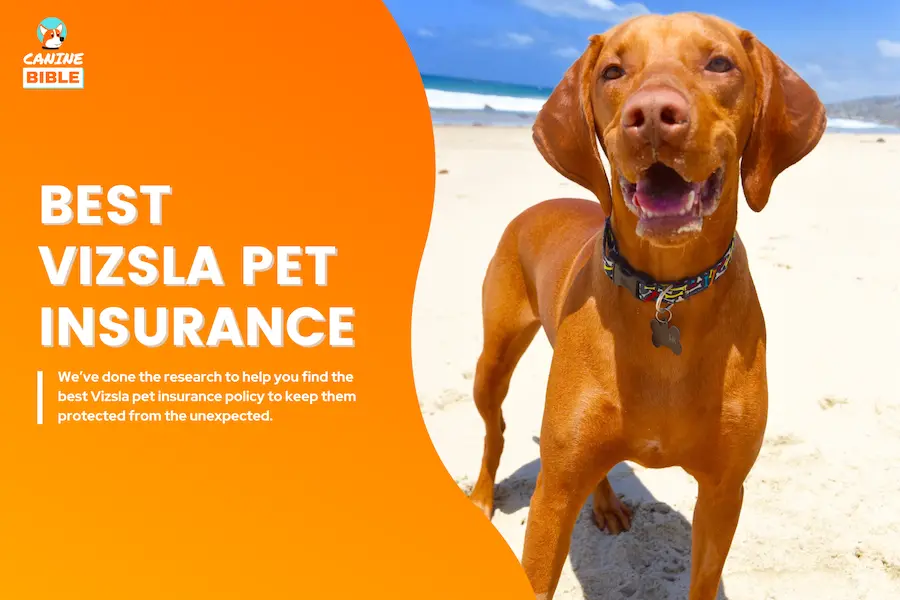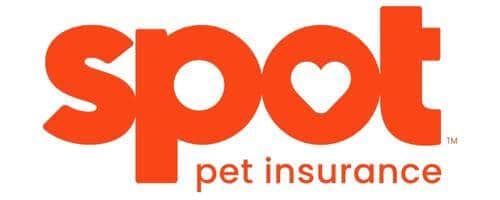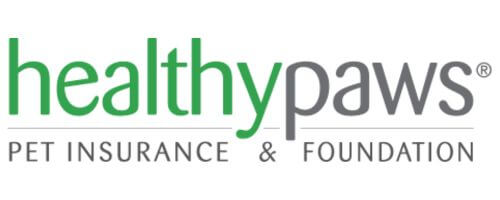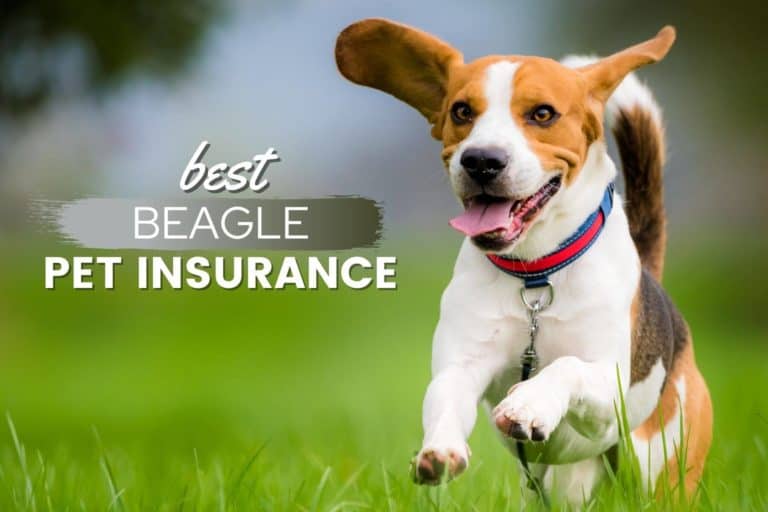Best Pet Insurance For Vizslas

Canine Bible is reader-supported. We receive affiliate commissions via some of our links. This doesn’t affect rankings. Learn more.
If you own a Vizsla, you know just how smart and active these dogs can be. And with all that activity comes the potential for costly injuries and as with any breed of dog, Vizslas are also prone to health problems. That’s why it is important to have pet insurance for Vizslas in case something unexpected happens. In this post, we will discuss the cost of pet insurance for Vizslas and quotes from some of the top providers. We will also provide breed-specific tips on how to find the best plan for your Vizsla. So read on to learn more!
Why you should trust us: Our writers, editors, and in-house veterinarians spend hours analyzing and reviewing products and services to help find what’s best for you. Read the product review methodology and editorial mission to find out how we test, analyze, and rate.
Best Vizsla Pet Insurance — At A Glance
What Is Vizsla Pet Insurance?
Pet insurance is a healthcare policy that provides coverage for your pet and reimburses specific veterinary expenses. This ensures that your savings remain secure despite unforeseen medical costs. Such a policy involves a monthly premium. Should your pet fall ill or sustain an injury, you would file a claim with the insurance company to recoup your expenses.

The monthly premium for Vizsla pet insurance
$39 to $77
How Much Does Pet Insurance Cost For Vizsla?
The cost of pet insurance for a Vizsla dog will vary based on several factors, including the pet’s existing health conditions, sex, age, and the area you reside in. It’s important to remember that with the progression of veterinary technology and increased claims within your locality, your insurance premiums may rise. For example, even if your Vizsla is quoted at $55 per month, this rate is not fixed and could change.
According to our research, plans for Vizslas can range from $39 to $77. You may spend more or less depending on where you live, the deductible rate and the reimbursement percentage you choose. Vizsla owners can expect to pay an average $57 monthly premium.
Pet Insurance Quotes For Vizslas
We compared quotes from renowned pet insurance providers to estimate your expected average monthly premium for different life stages in Vizslas.
| Company | Deductible | Reimbursement | Annual Reimbursement Limit | Monthly Price | Location | Gender | Breed | Age |
|---|---|---|---|---|---|---|---|---|
| Lemonade | $500 | 70% | $100,000 | $40.87 | SC, 29044 | Male | Vizsla | 6 years |
| Spot | $500 | 70% | Unlimited | $71.48 | SC, 29044 | Male | Vizsla | 6 years |
| Healthy Paws | $500 | 70% | Unlimited | $60.96 | SC, 29044 | Male | Vizsla | 6 years |
| Lemonade | $500 | 70% | $100,000 | $38.88 | CA, 95842 | Female | Vizsla | 2 year |
| Spot | $500 | 70% | Unlimited | $75.16 | CA, 95842 | Female | Vizsla | 2 year |
| Healthy Paws | $500 | 70% | Unlimited | $49.80 | CA, 95842 | Female | Vizsla | 2 year |
| Lemonade | $500 | 70% | $100,000 | $46.77 | TX, 75219 | Female | Vizsla | 6 months |
| Spot | $500 | 70% | Unlimited | $77.33 | TX, 75219 | Female | Vizsla | 6 months |
| Healthy Paws | $500 | 70% | Unlimited | $54.07 | TX, 75219 | Female | Vizsla | 6 months |
Vizsla puppy monthly cost: $59
Adult Vizsla monthly cost: $55
Senior Vizsla monthly cost: $58
Is Pet Insurance For Vizslas Worth it?
The decision to purchase pet insurance for your Vizsla hinges on various factors, including your pet’s health risk proclivity, tolerance for financial risk, and overall financial circumstances.
Consider a scenario where your Vizsla falls seriously ill or suffers an injury from an accident, incurring veterinary bills in the thousands. On average, the most common dog treatments cost $254.[1] A more severe and common condition in Vizsla, like Bloat, can cost between $1,500 and $7,500 to diagnose and treat. Can you pay for an unexpected $7,500 veterinary bill out-of-pocket? Most people can’t. The Federal Reserve states that 40% of Americans don’t have enough savings to cover a $400 emergency and 57% of U.S. adults cannot afford a $1,000 emergency expense.[2]
Investing in pet insurance for your Vizsla is a wise choice to protect your finances and ensure your dog can receive the necessary care. With pet insurance, should an unexpected accident or illness occur, you could be reimbursed for 70% to 100% of the veterinary costs, depending on the details of your plan and provider. Pet insurance gives peace of mind, knowing your finances and pet’s health are covered.
Predict & Protect Your Vizsla’s Future Health
Canine Bible uses years of clinical health findings, pet insurance data points, trends, and surveys to identify common health conditions in dogs. By gaining insight into your Vizsla’s potential future health issues and risks, you can take preventive action today and ensure that your Vizsla does not become a part of these statistics.
1 in 3
dogs will need emergency veterinary treatment every year.
$250 to $8K
is the average cost of unexpected veterinary care for dogs.[3]
24.1 %
Vizsla could experience some type of cancer.
25.9%
of Vizsla may experience behavioral disorders.[4]
Dogs that develop chronic conditions under pet insurance coverage are guaranteed reimbursement for these issues for the duration of their life. If you know your dog’s breed is predisposed to certain health issues, we strongly advise getting a pet insurance policy while your dog is still healthy. Chronic health conditions, emergencies, and vet visits can increase costs throughout your Vizsla’s life. Pet Insurance can spare you a lot of financial trouble.
How Pet Insurance Helps With Common Health Conditions In Pomeranians
Cost to treat cardiomyopathy
Cancer in dogs is the abnormal growth of cells in their body, often leading to tumors. It can affect any organ, showing varied symptoms, and requires veterinary diagnosis and treatment.
*The overall cost of diagnosing and treating illnesses and injuries may vary. The above cost is based on average veterinary vet bill reports and claims submitted by pet insurance policyholders. We’ve used a 90% reimbursement rate for this scenario.
Cost to treat aortic stenosis
Aortic stenosis in Vizslas dogs is a heart condition where the aortic valve narrows, hindering blood flow from the heart. It can cause fatigue, fainting, and heart murmurs.
*The overall cost of diagnosing and treating illnesses and injuries may vary. The above cost is based on average veterinary vet bill reports and claims submitted by pet insurance policyholders. We’ve used a 90% reimbursement rate for this scenario.
Cost to treat bloat
Bloat, also known as gastric dilatation-volvulus, is a rapid stomach expansion with gas and often a twist that obstructs blood flow. It’s a life-threatening emergency that causes distress, drooling, and a swollen belly.
*The overall cost of diagnosing and treating illnesses and injuries may vary. The above cost is based on average veterinary vet bill reports and claims submitted by pet insurance policyholders. We’ve used a 90% reimbursement rate for this scenario.
Cost to treat hypothyroidism
Hypothyroidism is a condition where the thyroid gland underproduces hormones, leading to symptoms like lethargy, weight gain, skin issues, and fur thinning. It’s commonly treated with hormone replacement therapy.
*The overall cost of diagnosing and treating illnesses and injuries may vary. The above cost is based on average veterinary vet bill reports and claims submitted by pet insurance policyholders. We’ve used a 90% reimbursement rate for this scenario.
Cost to treat entropion
Entropion in Vizslas is a condition in which the eyelid rolls inward, causing the eyelashes to rub against the cornea. This results in discomfort, tearing, and potential corneal damage. It’s often inherited, though it can also arise from eyelid injuries or muscular spasms. Treatment typically involves surgical correction.
*The overall cost of diagnosing and treating illnesses and injuries may vary. The above cost is based on average veterinary vet bill reports and claims submitted by pet insurance policyholders. We’ve used a 90% reimbursement rate for this scenario.
Cost to treat hip dysplasia
Hip dysplasia involves abnormal development of the hip joint, leading to looseness and instability. This genetic disorder is exacerbated by rapid growth, obesity, and environmental factors. Symptoms include limping, difficulty in movement, and arthritis.
*The overall cost of diagnosing and treating illnesses and injuries may vary. The above cost is based on average veterinary vet bill reports and claims submitted by pet insurance policyholders. We’ve used a 90% reimbursement rate for this scenario.
Cost to treat epilepsy
Epilepsy in Vizslas is a neurological condition characterized by recurrent seizures, which can range from mild, barely noticeable episodes to severe convulsions. The cause is often genetic, making it a hereditary issue within the breed. Managing epilepsy typically involves long-term medication to control seizures and regular veterinary monitoring.
*The overall cost of diagnosing and treating illnesses and injuries may vary. The above cost is based on average veterinary vet bill reports and claims submitted by pet insurance policyholders. We’ve used a 90% reimbursement rate for this scenario.
Cost to treat mitral valve disease
Vizslas often suffer from mitral valve disease, where the heart’s mitral valve deteriorates. This leads to blood flow issues and potential heart failure. Aging and genetic factors predominantly cause this condition, affecting the dog’s overall cardiac health and stamina.
*The overall cost of diagnosing and treating illnesses and injuries may vary. The above cost is based on average veterinary vet bill reports and claims submitted by pet insurance policyholders. We’ve used a 90% reimbursement rate for this scenario.
Why Get Pet Insurance For Vizslas?
Benefits For Vizslas
Benefits For Owners
How to Pick The Best Vizslas Pet Insurance
Best Pet Insurance For Vizslas
1. Best Overall Vizslas Pet Insurance
Deductible: $100, $250, $500 or $750
Reimbursement rates: 70%, 80% or 90%
Annual payout limit: $5K, $10K, $20K, $50K or $100K
Why we picked and recommended it: We named Lemonade our best overall pet insurance for Vizslas for its comprehensive coverage, pricing, availability, and customer service. Lemonade premiums usually start at just $10 monthly, the lowest in the industry. We ran a few quotes for a healthy Vizsla at a $500 deductible and 70% coverage to estimate your monthly premium. Based on our research, you can expect to pay between $39 and $47 monthly. We love that Lemonade is tech-forward, making it easy to manage your policy and file claims through an app. Their plans cover accidents and illnesses, including injuries, poisonings, broken bones, sprains, infections, general sicknesses, cancer, heart disease, hip dysplasia, hernias, skin conditions and more. They also offer several add-ons to help pet owners pay for exam fees, physical therapy, and preventive care.
2. Best Personalized Vizsla Pet Insurance
Deductible: $100, $250, $500, $750 or $1,000
Reimbursement rates: 70%, 80% or 90%
Annual payout limit: $2,500 to Unlimited
Why we picked and recommended it: Spot Pet Insurance offers seven annual limit options, three reimbursement levels, and five annual deductibles. They offer the lowest deductible in the industry ($100), meaning that when your Vizsla gets sick, you pay less upfront before your plan starts paying. With so many customization options, this company is our top pick for finding a plan to meet your specific financial needs and those of your pet. Spot’s policies also cover some items, such as exam fees and microchipping, that many other pet insurance providers don’t offer. They also have one of the cheapest plans for accident-only coverage, making it perfect for pet owners who only need minimal coverage. We ran a few quotes for a healthy Vizsla at a $500 deductible and 70% coverage, based on our research, you can expect to pay between $71 and $77, but prices may vary depending on your location, Vizsla’s age, and other factors. Spot covers you when your Vizsla gets hurt unexpectedly, from tooth extractions and torn ligaments to surgery and hospitalizations.
3. Best No-Cap Payout Vizsla Pet Insurance
Deductible: $100, $250 or $500
Reimbursement rates: 70%, 80% or 90%
Annual payout limit: Unlimited
Why we picked and recommended it: Healthy Paws offers the benefit of no cap payout, meaning there’s no maximum limit on the amount they will pay, which is particularly advantageous for severe conditions or chronic diseases that require ongoing, expensive treatments. With no financial cap, you can choose the best treatments for your pet. This can include access to advanced medical procedures, specialized surgeries, or cutting-edge treatments that might otherwise be prohibitively expensive. Additionally, Healthy Paws stands out for its quick claim processing, typically paying 99% of claims in two days, notably faster than many competitors. We ran a quote for a healthy Vizsla at a $500 deductible with 70% coverage. Depending on your location, pet’s age, and other factors, you can expect to pay between $50 and $61. Healthy Paws insurance plans cover accidents and illnesses, cancer, emergency care, genetic conditions, alternative care, etc. They have competitive premium prices and fewer coverage exclusions.
Types of Pet Insurance Coverage For Vizslas
There are two main types of pet insurance plans.

What Does Pet Insurance Not Cover?
When choosing pet insurance for your Vizsla, reviewing and understanding your policy’s exclusions is important.
Exclusions vary based on the pet insurance company and the policy you choose. Be sure to review the list of exclusions before purchasing pet insurance to confirm that your Vizsla is adequately covered by the plan you select and help prevent surprises in the future.
Pet Insurance For Vizsla Puppies
Should you get pet insurance for your Vizsla puppy? Here are the top reasons you should consider Vizsla] puppy insurance.
Average Cost of Vizsla Vet Bills
This is what you will pay out-of-pocket on average if you don’t have pet insurance or a wellness plan.
Average Cost of Typical Vet Procedures
| Typical Vet Procedure | Average Cost of Procedure |
|---|---|
| Puppy vaccinations | $75 - $100 |
| Flea & tick prevention | $40 - $200 |
| Heartworm prevention | $24 - $120 |
| Spay or neuter surgery | $200 - $800 |
| Annual exam | $240 - $600 |
| Teeth cleaning | $200 - $500 |
| Microchip | $40 |
Average Cost of Emergency Vet Procedures
| Typical Vet Procedure | Average Cost Of Procedure |
|---|---|
| General consultation/exam | $100 - $150 |
| General bloodwork | $80 - $200 |
| X-rays | $150 - $250 |
| Ultrasound | $300 - $600 |
| 1-2 day hospitalization | $600 - $1,700 |
| 3-5 days holspitalization | $1,500 - $3,500 |
| Wound treatment & repair | $800 - $1,500 |
| Emergency surgery | $800 - $2,500 |
| Oxygen therapy | 500 |
Sources: 5 & 6
Factors That Impact the Cost of Your Vizsla Pet Insurance Policy
Deductibles, co-pays & coverage limits
The lower the amount you pay out of pocket for your pet’s care, the higher your insurance premium will be. For instance, selecting a deductible of $300 instead of $800 means you’ll get reimbursed quicker for your pet’s care, but it also leads to higher premium payments.
Breed
Certain breeds are prone to congenital health issues. For example, breeds such as Vizsla often struggle with Cancer and bloat. These breed tendencies could influence your pet insurance expenses.
Location
Local veterinary care expenses are taken into account by pet insurance companies when setting the price of your policy.
Pet’s Age
Older pets generally face more health problems, which results in higher insurance premiums because there is a higher risk for the insurance company.
Understand Insurance Policy Basics
How Does Vizsla Pet Insurance Work?
Imagine your Vizsla’s pet insurance policy has the following terms:
Now, let’s say your Vizsla incurs a veterinary bill of $3,000 for medical treatment.
This example assumes you haven’t yet met your deductible for the year. If you’ve already met your annual deductible, you won’t have to pay again for this or any new claims within the same policy year. And, since every claim you make contributes to your annual payout limit after the insurance company pays $2,160 for this claim, the remaining yearly payout limit is $20,000 – $2,160 = $17,840.
Frequently Asked Question
Vizslas Pet Insurance — Conclusion
When choosing the best pet insurance for your Vizsla, there are many things to consider. Cost, quotes, and plans vary widely, so it’s essential to research before making a decision. The most important thing is ensuring you’re getting coverage that meets your dog’s health needs and budget. We hope our guide has helped you search for the perfect policy for your furry friend.
Like It? Subscribe & Share!
Disclaimer: The details about insurance company offerings, including prices, availability, and contract specifics, can change at any time and are at the discretion of the insurance company. This website does not control these changes. The information provided here is for reference only. It is important to thoroughly read and understand your policy before signing up for a new insurance contract, as your situation may differ from the examples used in this article.
Sources
Canine Bible uses only high-quality sources, including peer-reviewed studies, to support the facts within our articles. Read our editorial process and product review methodology to learn more about how we fact-check, test products, and keep our content accurate, reliable, and trustworthy.
- Breiner, B. (2023). Average Cost of Pet Insurance: 2023 Quotes. ValuePenguin.
- Gillespie, L. (2023, February 23). Bankrate’s Annual Emergency Fund Report. Bankrate.
- Healthy Paws Pet Insurance. (2019). 2019 Cost of Pet Health Care Report.
- Zink, M. C., Farhoody, P., Elser, S. E., Ruffini, L. D., Gibbons, T. A., & Rieger, R. H. (2014). Evaluation of the risk and age of onset of cancer and behavioral disorders in gonadectomized Vizsla. Journal of the American Veterinary Medical Association, 244(3), 309–319.
- Average Cost Of Emergency Vet Visits | Find Out What You Will Pay. (2020, March 19). Emergency Vets USA.
- Cost of Owning a Dog: From Initial Cost to Annual Essentials. (n.d.). The Dog People.
Dr. Aukse is our in-house Lead Senior Veterinarian. Dr. Aukse is a dedicated and skilled DVM Surgeon renowned for her expertise in small/companion animal surgery and medicine. With a robust academic background and extensive hands-on experience, she ensures her patients receive the highest standard of care. Dr. Aukse is happy to share her knowledge and expertise with our readers.
Dr. Caraite's career experience as a DVM Veterinary Surgeon spans over seven years, marked by comprehensive learning from esteemed institutions and substantial experience in veterinary clinics. She is currently employed at a family-run, day-opening clinic in central Gothenburg, Sweden, where she performs surgery daily and manages a large patient base for both surgical and outpatient care. Her externship at North Carolina State University’s College of Veterinary Medicine, with a focus on soft tissue and oncology service, has further honed her skills, equipping her with the essential knowledge and proficiency to excel in her field.
Dr. Aukse holds a Master’s in Veterinary Medicine (DVM) from the Lithuanian University of Health Sciences (2017) and has completed an externship in Soft Tissue and Oncology Service at NC State (2018-2023). She is also has a Master’s in Small Animal Surgery with a specialization in Dog and Cat Surgery from the University of Copenhagen.











![Best Dog Food For Saint Bernards: Breed-Specific Picks [2024]](https://www.caninebible.com/wp-content/uploads/2023/06/best-dog-food-for-Saint-Bernards-768x512.png)

![Best Dog Food For Standard Schnauzers: Nutritious & Tasty [2024]](https://www.caninebible.com/wp-content/uploads/2023/09/Best-Dog-Food-For-Standard-Schnauzers-768x512.png)